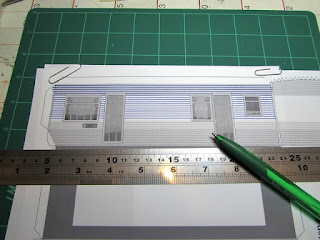Here's the result, and it wasn't as quick to achieve this as you might think...
Having downloaded the kit and read the instructions I promptly decided to largely ignore them. They say to print it on 160-180 gsm card but I chose to use lightweight matt photopapaper as it has a much smoother surface. This was then stuck to card of undetermined weight but likely 200 gsm+, using an acid free glue stick. Once dry I then opted to emboss the corrugations in the caravan sides and ends to give a little texture. To achieve this without damaging the prints I printed the relevant parts again on plain copier paper and overlaid this carefully on the parts, then went up and down each line twice, avoiding the windows and doors.
Of course this is pretty hard to photograph once embossed, you can just see it around the door here.
You might be wondering why I left the windows and doors alone. Well, the kit includes a full set of separate parts to overlay on top of the sides to reproduce the frames on a real caravan that sit proud of the sides, but they repeat the printed window detail that is represented on the sides. I had other plans.... I did not stick these parts to the card as per the sides, but cut out the centre of each frame and then carefully stuck each group of windows to clear material (possibly an old overhead projector transparency) using Johnson's 'Kleer'. Once dry I was able to cut out each door/window with a frame and glass, the effect of which can be seen here posed on the printed side. The idea is to get a greater sense of depth.
As can be seen, by this point I had cut abandoned the intended style of construction of folding up the floor/sides/ends and adding formers and a roof, as I felt that would produce something rather flimsy. Instead I opted to cut out the parts and use them around a more substantial supporting structure, made from 1.5mm mount board and treated with Button Polish (shellac). This included internal formers to hold the roof in place and strengthening triangles to reinforce the joints.
I had simplified the roof profile from that printed in the kit as it didn't look quite right and it was much easier to create a simple shallow radius. Underneath the printed box that represented the chassis framework in the kit was replaced with a lattice cut from card and more sections of mount board.
In a fit of laziness, and a desire to move on what should have been a simple card kit build that was taking a lot longer than expected, I sprayed the roof and underside of the structure with grey primer. The next day I added all the printed parts and then some carefully folded corner strips from the matt photo paper to hide the corner joins. Once these were dry I ran a pencil over them to tone down the brightness. I then carried out what could have been a ruinous exercise and gently wafted a can of Humbrol acrylic matt varnish over the painted and printed parts to help seal the print and tone it down a touch. This almost went too white but it is generally OK. Once dry I added the window and door units using double-sided tape.
I find that the contrast between the matt of the sides and the gloss of the glazing and the sense of depth between the front window frame and the printed panel behind is almost enough to hide the fact that the interior is not modelled. It would certainly work as a background model and my thinking is that this and the other caravan kits in the range would be very suited to creating a caravan park behind a wall/fence/bush as part of a backscene, using the sides and ends as flats but employing the embossing and window techniques used here.
I've opted to halt at this point until I decide what to do with it. You may have spotted that I've not added any wheels or the jockey wheel, I was thinking of raiding my 4mm scale vehicle wheels to assist with these.
Colin







No comments:
Post a Comment